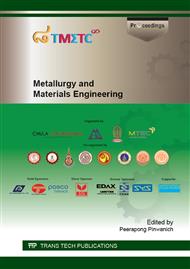p.25
p.31
p.36
p.42
p.53
p.59
p.64
p.69
p.76
Determination of 3D Ductile Failure Criteria for Advanced High Strength Steel Sheet
Abstract:
In this work, 3D ductile fracture locus was determined for the advanced high strength (AHS) steel sheet grade DP780 using a hybrid approach between experiment and FE simulation. Tensile tests of different sample geometries were performed for the investigated dual phase steel, by which varying stress triaxiality (η) and lode angle (θ) values developed in the material during loading were introduced. During the tests, the direct current potential drop (DCPD) method and digital image correlation (DIC) technique were applied for identifying crack initiation on the micro-scale and fracture of the specimens due to local plastic deformation. Obtained force and displacement curves were correlated with the electric potential curves. Then, the moments of crack onset were determined for various states of stress. In parallel, the most critical areas of deformed samples before fracture were observed by the DIC method. Subsequently, FE simulations of the tensile tests were carried out and calculated local stresses and strains were gathered. The stress triaxialities, equivalent plastic strains and lode angles were evaluated for the corresponding detected areas. These threshold variables obtained from different specimens were plotted as the 3D failure locus for defining crack initiation and fracture occurrence in the DP steel.
Info:
Periodical:
Pages:
53-58
Citation:
Online since:
July 2015
Authors:
Price:
Сopyright:
© 2015 Trans Tech Publications Ltd. All Rights Reserved
Share:
Citation:


